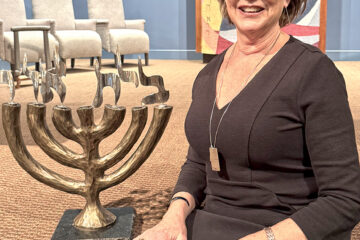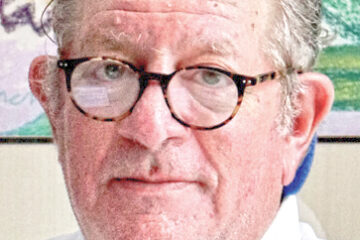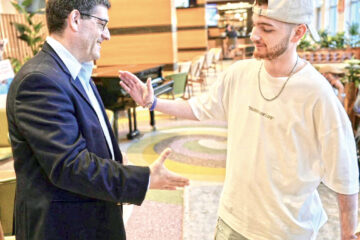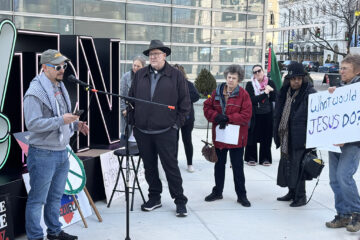Memorial on Global Stage
By Martha Moody Jacobs
Special To The Dayton Jewish Observer
Ten years ago, the assassination of Yitzhak Rabin brought Dayton Peace Accords figures to Temple Israel
On Sunday, Nov. 5, 1995, the Dayton Jewish community played an unexpected role in the struggle for world peace.
At that time, Dayton and Wright-Patterson Air Force Base were on the international stage, hosting the negotiators who would hammer out the political divisions and government structure of Bosnia and Herzegovina, parts of the former Yugoslavia that were immersed in brutal ethnic fighting.
The Croatian, Serbian, and Bosnian presidents and their negotiating teams were here, as were American negotiators led by Richard Holbrooke.
On day four of the negotiations, Israeli Prime Minister Yitzhak Rabin was shot and killed at a peace rally in Tel Aviv.
Don Cohen, then director of Dayton’s Jewish Community Relations Council, was phoned Saturday afternoon by a local newspaper religion writer with news of Rabin’s death.
In short order, the JCRC decided to hold a memorial service the following evening at Temple Israel.
Plans for the service were announced at a Saturday evening press conference.
Cohen recalls sitting at the Federation until 3 a.m. Sunday morning, working on the service and digesting the news.
Early reports confirmed that Rabin’s assassin was an Israeli Jew. Yigal Amir later claimed he killed Rabin to halt Israel’s peace process with the Arabs.
During the meeting to plan Dayton’s memorial service, the group discussed what Rabbi Mark Glickman calls the “weird convergence of events” that brought peace negotiators to Dayton at the time of Rabin’s murder. They decided to invite the negotiators to the service.
“I phoned Wright-Patt and said I’d like to speak to the negotiators,” Glickman, then associate rabbi at Temple Israel, remembers.
Glickman asked for the American delegation and was put through. He talked to a young aide. Several hours later, he heard that representatives were coming.
“The number two guys came,” Glickman says. Richard Holbrooke sent then Lt. Gen. Wesley Clark.
The Croatians sent their ambassador to the UN and their military attaché.
The Bosnians sent their ambassador-at-large and their ambassador to the United States, Sven Alkalhaj, a Jew from Sarajevo who wore a yarmulka during the service.
The Serbian president, Slobodan Milosevic, now on trial for war crimes, did not attend, but was represented by Yugoslavia’s deputy foreign minister.
People lined the walls and clustered at the back door of Temple Israel’s sanctuary. “It filled a need to gather and express feelings,” says Rabbi P. Irving Bloom, now rabbi emeritus of Temple Israel.
The negotiators arrived just before the service and sat in front.
Security people came with them, Temple Israel’s then-Executive Director Bruce Rickenbach recalls, but no one was stopped or searched.
Jewish, Catholic, Protestant, and Muslim leaders participated on the program.
Clark was among the speakers. He said Rabin had once told him the most important quality for a soldier was persistence.
“Clark talked about how Rabin extended himself for peace. It was like he was tweaking the negotiators,” Cohen recalls.
A book filled with signatures and messages from the participants was later sent to Rabin’s widow, Cohen says.
Glickman, who now serves Congregation Kol Shalom on Bainbridge Island, Wash., wasn’t at the service. “I had a prior commitment of a field trip or something,” he says, laughing ruefully. “I was young.”
Rickenbach also didn’t make it to the service. He was outside in the parking lot, directing traffic. Only later did he think about the import of the event.
“Richard Holbrooke said that all these little pieces had to fall into place for the negotiators to make a treaty,” Glickman muses. “It was an opportunity for us in the Jewish community to be part of history.”





